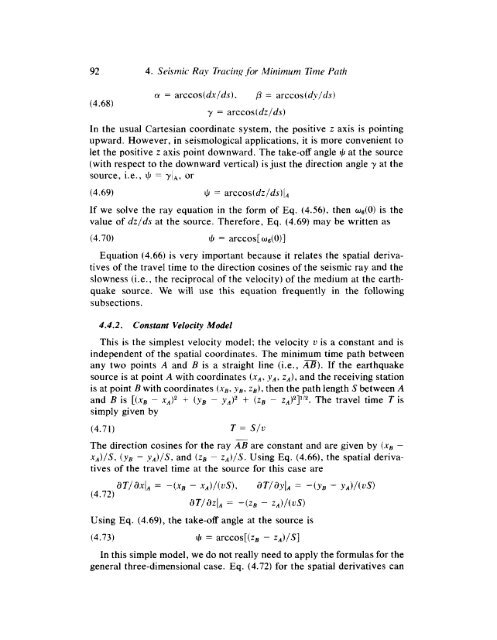principles and applications of microearthquake networks
principles and applications of microearthquake networks
principles and applications of microearthquake networks
You also want an ePaper? Increase the reach of your titles
YUMPU automatically turns print PDFs into web optimized ePapers that Google loves.
92 4. Seismic Ruy Tracing for Minimum Time Path<br />
(4.68)<br />
a = arccos(dx/ds).<br />
y = arccos(dz/ds)<br />
p = arccos(dy/ds)<br />
In the usual Cartesian coordinate system, the positive z axis is pointing<br />
upward. However, in seismological <strong>applications</strong>, it is more convenient to<br />
let the positive z axis point downward. The take-<strong>of</strong>f angle I#J at the source<br />
(with respect to the downward vertical) is just the direction angle y at the<br />
source, i.e., + = yIA, or<br />
(4.69) $ = arccos(dz/ds)/A<br />
If we solve the ray equation in the form <strong>of</strong> Eq. (4.56), then ws(0) is the<br />
value <strong>of</strong> dz/ds at the source. Therefore, Eq. (4.69) may be written as<br />
(4.70) $ = arccos[w6(0)]<br />
Equation (4.66) is very important because it relates the spatial derivatives<br />
<strong>of</strong> the travel time to the direction cosines <strong>of</strong> the seismic ray <strong>and</strong> the<br />
slowness (Le., the reciprocal <strong>of</strong> the velocity) <strong>of</strong> the medium at the earthquake<br />
source. We will use this equation frequently in the following<br />
subsections.<br />
4.4.2. Constant Velocity Model<br />
This is the simplest velocity model; the velocity v is a constant <strong>and</strong> is<br />
independent <strong>of</strong> the spatial coordinates. The minimum time path between<br />
any two points A <strong>and</strong> B is a straight line (i.e., AT). If the earthquake<br />
source is at point A with coordinates (xA,<br />
zA), <strong>and</strong> the receiving station<br />
is at point B with coordinates (xs, Ve, zB), then the path length S between A<br />
<strong>and</strong> B is [(xB - xA)2 + (ys - yA)2 + (za - zA)*]”*. The travel time T is<br />
simply given by<br />
(4.71) T = S /E<br />
The direction cosines for the ray are constant <strong>and</strong> are given by (xE-<br />
xA)/S, (Ys - yA)/S, <strong>and</strong> (zB- zA)/S. Using Eq. (4.661, the spatial derivatives<br />
<strong>of</strong> the travel time at the source for this case are<br />
aT/ax/A = -(xB - xA)/(ns), aT/ay(A = -(YE - 4)A)/(uS)<br />
(4.72)<br />
aT/azl, = -(zB - zA)/(us)<br />
Using Eq. (4.69), the take-<strong>of</strong>f angle at the source is<br />
(4.73) 4 = arccos[(zB - zA)/S]<br />
In this simple model, we do not really need to apply the formulas for the<br />
general three-dimensional case. Eq. (4.72) for the spatial derivatives can






